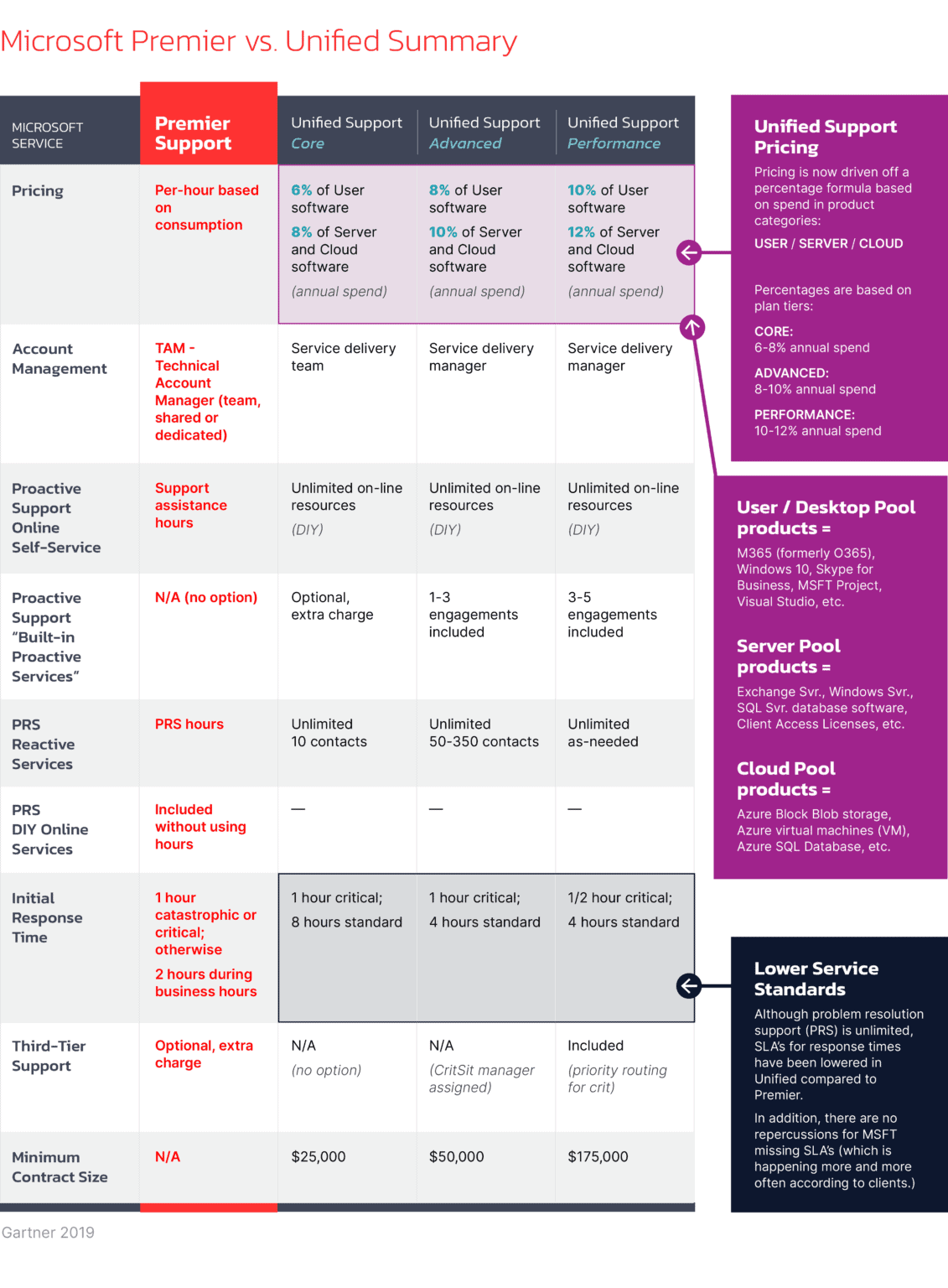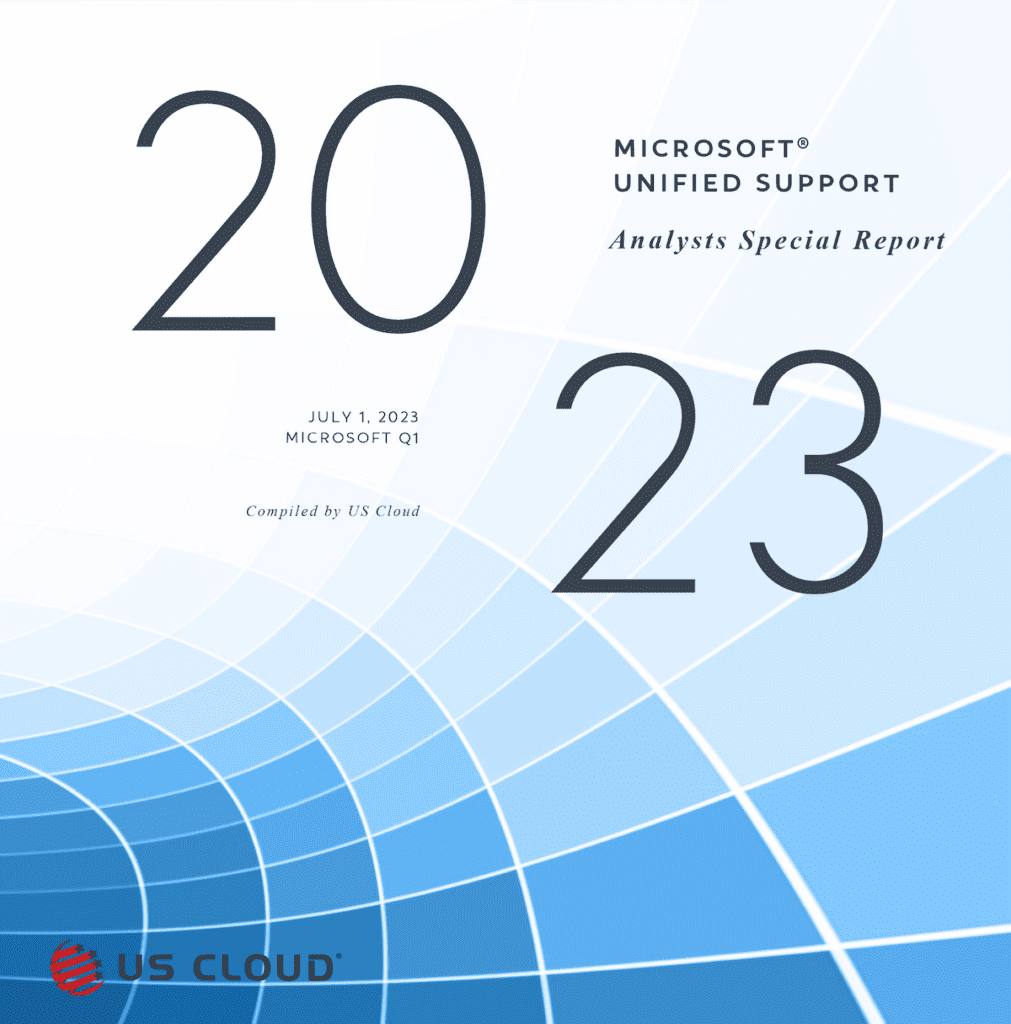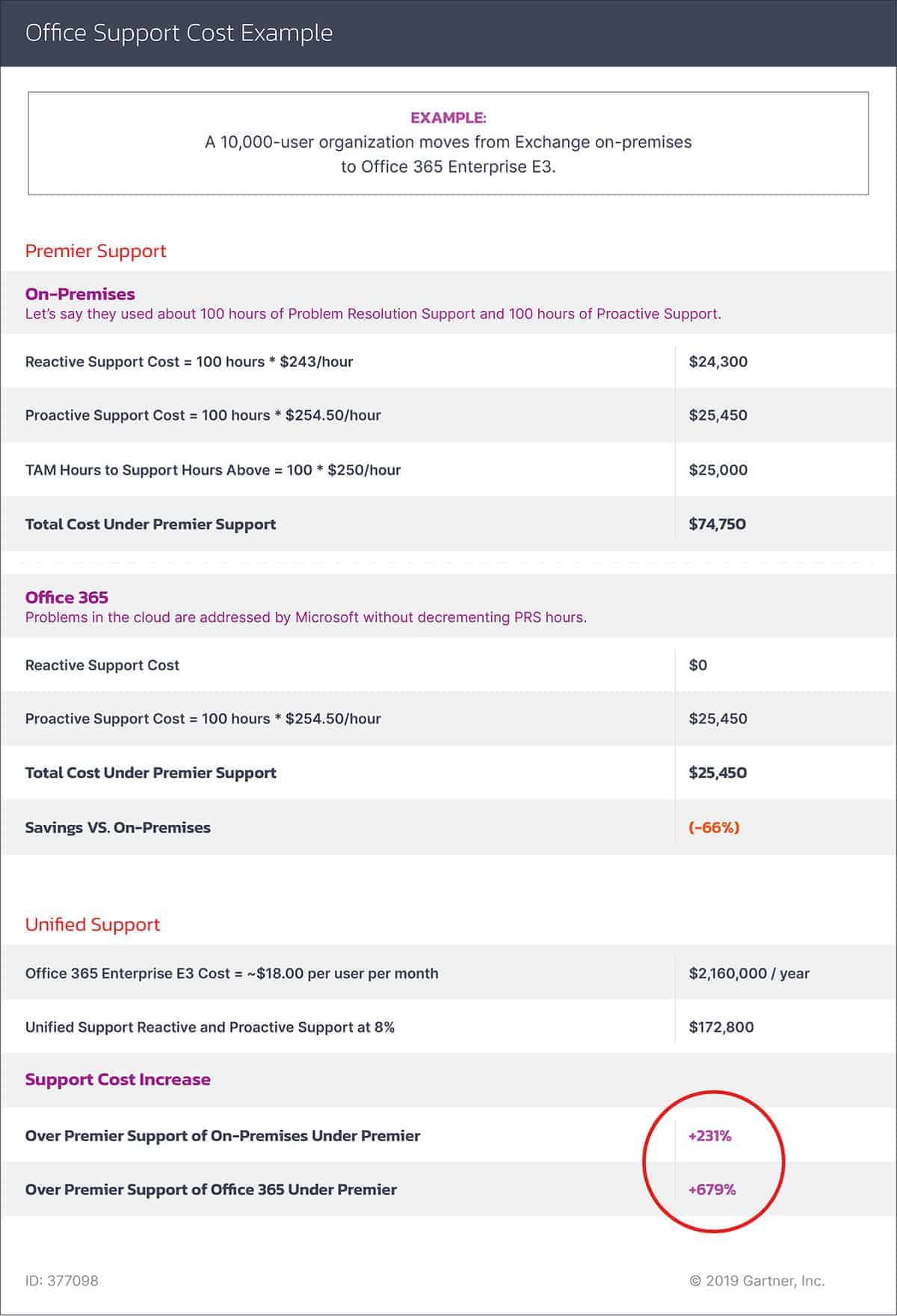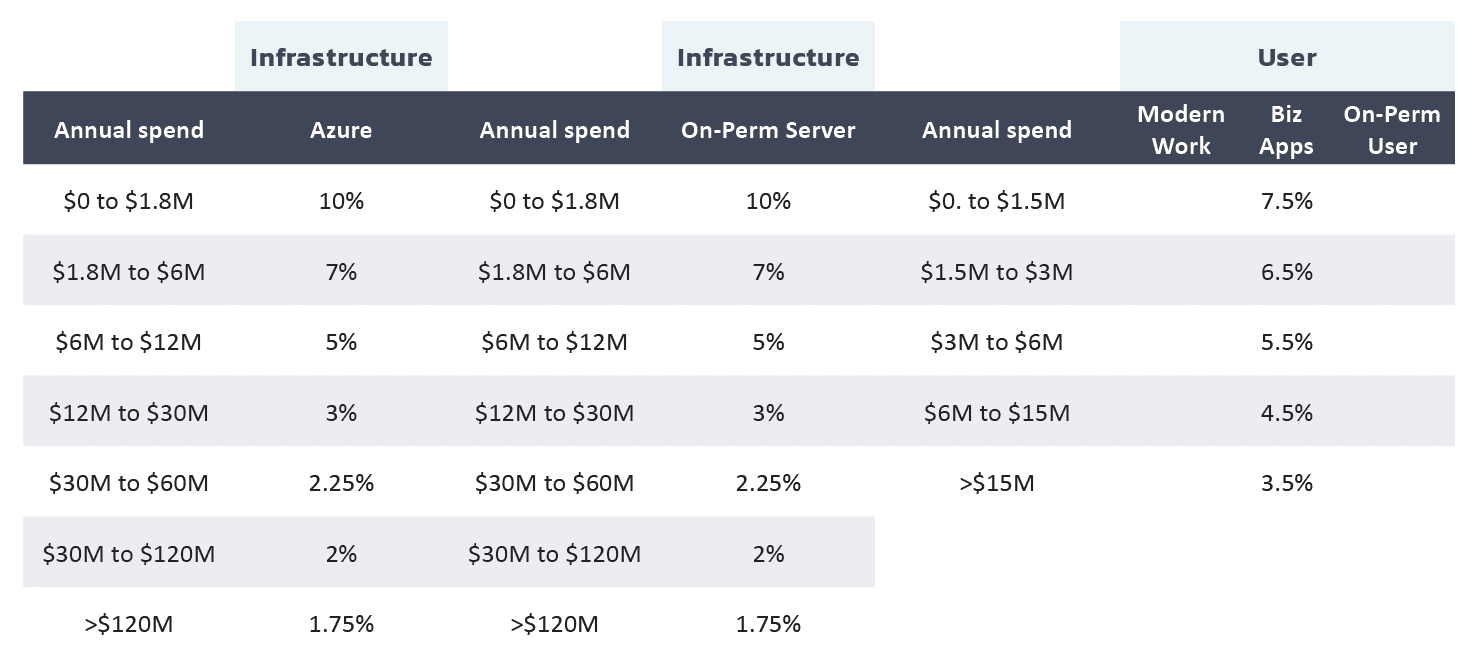
Educate and Prep for Unified.
Gov / Edu moving from Premier to Unified, or Enterprises renewing Unified agreements must prepare to win

Microsoft Premier vs. Unified Support Agreement
There are several key differences between Microsoft Premier Support and MS Unified agreements.
• Premier Support agreements for all Commercial enterprises were retired July 1, 2022. Premier for all Federal, State, Local Government, State-owned enterprises and Education customers will be retired July 1, 2024.
• Premier offered SAB incident credits but were retired under the Unified agreement in February, 2023 contributing to Unified’s 2-3x cost increase.
• Premier Support response time SLA’s were replaced with slower “targets” or soft goals that are rarely met and have no consequences if missed in an enterprise’s Unified agreement.
• Unified agreement costs are calculated as a percentage of an enterprise’s total Microsoft annual spend, including Microsoft 365, Azure, and Dynamics.
• MS Unified Support agreements do away with buying only the reactive support hours you need, instead offering an “all you can eat” approach to break-fix support for an enterprise’s Microsoft software portfolio.
• Unified’s resolution times increasing under “as needed” ticket load. Premier support quality is falling as Unified’s service is delivered largely by offshored, outsourced Microsoft partners causing enterprise compliance/security concerns.
• Unified has Customer Success Account Managers (CSAM) instead of Premier’s Technical Account Managers (TAM). Unified’s less capable CSAM’s KPI is enterprise Cloud spend while Premier’s highly-revered TAM’s KPI was satisfaction.
Below is a comparison between Microsoft Premier Support and the MS Unified Support agreement levels – Core, Advanced and Performance.

Unexpected Unified Support Costs of Migrating to the Cloud
Microsoft Unified Support agreement costs are calculated as a percentage of annual expenditures of ALL Microsoft enterprise software in use, including Microsoft 365, Azure and Dynamics. For enterprises moving on-premise data center applications to the cloud, infrastructure savings are often used to justify the migration. What is often overlooked, however, is how that increase in M365, Azure or Dynamics spend impacts the enterprise’s Unified Support agreement costs.
Even when Unified Support is purchased as a 3 year agreement or tied to the Microsoft Enterprise Agreement (EA) in a concerted price protection effort by enterprise sourcing and procurement teams, the Unified Support cost baseline resets annually. In reality, this offers no price protection to enterprises and blocks them from considering third-party competitor alternatives to Microsoft Unified Support.
And worse, Enterprise IT leaders are often blindsided when support costs skyrocket, triggered by additional Microsoft cloud spend, lessening or even negating anticipated infrastructure savings.
Here is an example from Gartner on how MS Unified Support costs would be calculated for a 10,000-user enterprise:

Understand New Unified Terms and Microsoft Tactics
Unsurprisingly, there is a lot of confusion amongst Government and Education organizations making the transition from Microsoft Premier to Unified Support as well as those renewing existing Unified agreements or considering Unified Enteprise. Here are a few points to be aware of as you start your Unified agreement negotiations:
- Enterprises heading into year 2 of their Unified agreement are reporting an average price increase of 28% year-over-year. This is on top of the previous 30-300% price increases year 1 when originally transitioning from Premier.
- If Microsoft offers to let you “stay” in Premier Support, that is in name only. It is just a temporary discount on MS Unified Enterprise that is removed year 2.
- Designated Support Engineers (DSE) hours are still negotiated and paid for separately – they are not unlimited under Unified. Minimum DSE purchase hours have increased from Premier’s 400 hours to 600 in Unified.
- Microsoft Unified Support DSE hours and engineer-led proactive support credits (optional for additional fees) get a 30% up-charge added automatically for “Technical Account Manager (TAM) time.” These charges often are buried in the fine print of your Unified agreement. Enterprises need to look closely at the true cost of the Unified add-on services.
- Response and resolution times have detiorated and SLAs are now “targets” with no teeth in Unified agreements. Many enterprises are now forced to pay for premium add-ons such as Rapid Response, Tier-3 Direct, Microsoft 365 Direct and Mission Critical just to maintain response time standards they formerly received with Premier.
- Azure Rapid Response can be purchase for an additional fee, however, fine print indicates that it is only available during Microsoft’s regular business hours, 8am-5pm PT, Mon-Fri.
- Microsoft 365, Azure, and Dynamics already have base support included, but are still part of the MS Unified Enterprise Support price calculation.
- Enterprise software purchased without Microsoft Software Assurance (SA) over the past five years, and no longer in use, should be out of scope for Unified agreement pricing.
- Microsoft Support Sales has been reportedly delaying Unified agreement renewal discussions to “run out the clock” before introducing Unified price hikes. Enterprises should build in at least 60-days for Unified Support negotiations and don’t be afraid to demand an extension if Microsoft drags their feet.
"Special" Unified Pricing for Enterprises
Large enterprises who rely on Microsoft software are now being targeted with a “graduated tax” pricing model call Unified Enterprise Support. Microsoft’s progressive pricing model aims to take more from enterprises who “can afford to pay more.” Enterprises are pushing back on the Microsoft Unified Enterprise tax and seeking alternatives for more reasonable and fair pricing.
The biggest shortcoming of the new Unified Enterprise model is the elimination of your ability to select the level of support that is right for you and your company. Instead of choosing between Core, Advanced, and Performance, now you have a single tier with “Expected” response times, which will result in higher spend on support for most enterprises, but with a faster target response time for Azure.
Additionally, the pricing calculation, or “P” in the new Unified Enterprise model, is a factor of your Azure, server, and user spends, from the last 12 months (not 5 years). And, not surprisingly, most of our new customers saw quotes with a much higher YOY spend based off that new calculation. (Which is why almost 20% of the Fortune 500 are now US Cloud Microsoft Enterprise Support customers.)

Unified Enterprise Support Agreement Highlights
Here are the highlights of the Microsoft Unified Enterprise Support Services Agreement so that you don’t miss anything important hidden in the details.
- Rates start at 7.5% of spend…if you spend more than $120M in Azure and On-Prem support.
- Spend is dependent on underlying price of other Microsoft services. Expect 10%+ price increases.1
- No discounts, Problem Resolution Support (PRS) for Software Assurance (SA) is dead.
- Severity A critical – 1 hour response time not fast enough? Prepare for Rapid Response upcharge.
- All Unified Support is still based on weaker CSAM model, not the tried-and-true TAM model.
- Minimum Unified Enterprise Support spend is effectively $150,000, sorry small enterprises.
1 Source: Ballooning Software Prices Complicate Tech Spending, April 2023, The Wall Street Journal

Microsoft Unified Enterprise Support Land Mines
With growing economic uncertainty, enterprises around the world are closely scrutinizing their technology spends including Microsoft Unified Enterprise Support. Microsoft claims the benefits of Unified Enterprise include: industry-aligned pricing, cost optimization and cost cutting, productivity boost, reduction in critical downtime incidents, access to more services/resources, faster cloud support, designated account management, flexibility and choice in services, and transparent and predictable pricing.
Discover how Microsoft Unified Support for Enterprises helps you pay more and get less. Taking a closer look at the Unified Enterprise Support offering reveals at best embellishment and at worst, concealed land mines ready to destroy Enterprise IT budgets and sourcing/procurement team near-term cost reduction and long-term cost avoidance goals.
Let’s cover the land mines hidden in Unified Enterprise since they’re the hardest to detect and can do the most damage.
Industry Aligned Pricing – “Rates start at 7.5% to 10% which is well within the range of typical software and cloud vendors.” a) The AWS Enterprise support plan pricing is 3% of monthly AWS charges over $1M or about half the cost of Microsoft. You can add Incident Detection and Response for a 2% uplift. This service is similar to Microsoft’s Incident Response Retainer which is not included with Unified. b) Google Cloud premium support falls in between Microsoft and AWS with 4% of total spend and additional costs for mission critical, technical account manager, and government.
Cost Cutting / Cost Optimization – “Significantly reduce or eliminate the cost of risk assessments and training. Right size cloud usage and infrastructure post-migration using Proactive Services.” Risk assessment tools and training materials are readily available for Microsoft technologies at minimal cost to enterprises. Right-sizing and reducing Cloud waste is important but best managed outside the vendor platform. Unified’s typical 200% to 300% increase in cost over 5 years far outweighs risk assessments and right-sizing benefits.
Downtime Reduction / Productivity Boost – “67% reduction in critical downtime incidents.1 IT employees saved an average of 2.5 hours per support ticket handled by Microsoft.” Other than cost, the biggest issue with Unified Enterprise Support is resoundingly quality. If the numbers above are accurate, the gain of using a third-party competing alternative like US Cloud is even more compelling. US Cloud’s response time SLA of 15 minutes for all technologies and all severities means we get to work faster on every ticket. Enterprise IT employees aren’t frustrated with language barriers or wasting time restating issues when talking to US Cloud engineers. In addition, US Cloud is at least 25% faster at resolution across all domains which means less critical downtime and even more productivity from Enterprise IT with US Cloud Microsoft Enterprise Support.
1 Source: The Total Economic Impact™ of Microsoft Unified Support, June 2022: A commissioned study conducted by Forrester Consulting
